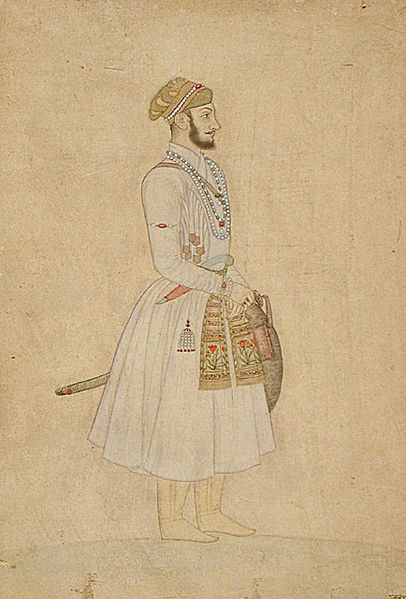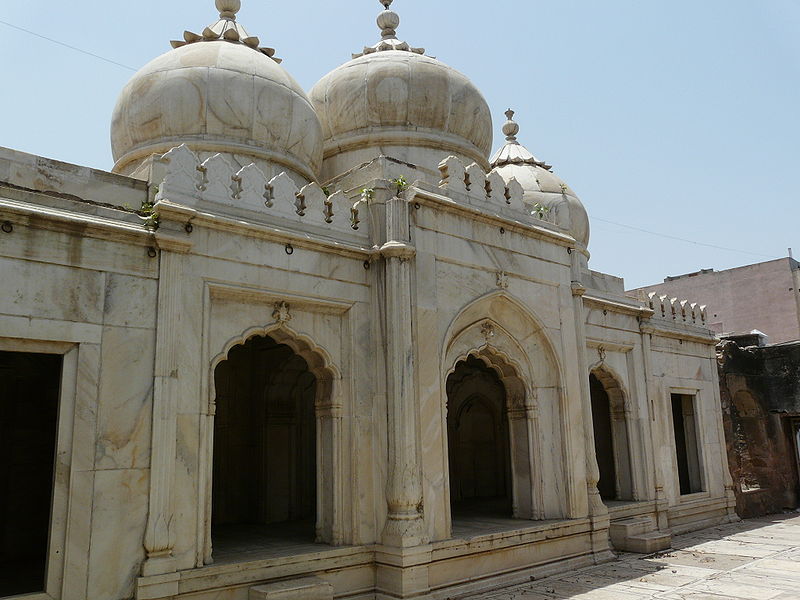<Back to Index>
- Nuclear Technician and Whistleblower Mordechai Vanunu, 1954
- Engraver and Cartographer Jodocus Hondius the Elder, 1563
- 7th Emperor of the Mughal Empire Bahadur Shah I, 1643
PAGE SPONSOR


Bahadur Shah (Persian: بہادر شاه Bahādur Shāh) (14 October 1643, Burhanpur – 27 February 1712, Lahore) was a Mughal Emperor, who ruled India from 1707 to 1711. His original name was Qutb ud-Din Muhammad Mu'azzam later titled as Shah Alam by his father. He took the throne name Bahadur Shah in 1707. His name Bahādur means "brave" & "hero" in Turko - Mongol languages. Reigning just five years, he was an old man of 63 when he came to power. He made settlements with the Marathas, tranquilized the Rajputs, and became friendly with the Sikhs in the Punjab. He was travelling throughout his reign and only came to rest in Lahore in the last few months of his life.
Muazzam, the third son of the emperor Aurangzeb through Nawab Bai Begum Saheba, the daughter of Raja of Rajauri (Jarral Rajput), was born in Burhanpur in 1643. In his father's lifetime, Muazzam was deputed governor of the northwest territories by Aurangzeb. His province included those parts of the Punjab where the Sikh faith was blossoming. As governor, Muazzam relaxed the enforcement of Aurangzeb's severe edicts, and an uneasy calm prevailed in the province for a brief time. In fact, he maintained a friendly relationship with the last Sikh spiritual leader, Guru Gobind Singh. When Muazzam was challenging his brothers for the Mughal throne, Guru Gobind Singh provided military assistance to the liberal prince.
After Aurangzeb's death, Muazzam Bahadur Shah took the throne. A war of succession began immediately after Aurangzeb died. One younger brother, Prince Azam Shah, proclaimed himself emperor and marched towards Delhi, where he unsuccessfully fought Bahadur Shah and died after a nominal reign of three months. Another brother, Muhammad Kam Baksh, was killed in 1709.
Aurangzeb had imposed Sharia law within his kingdom with harsh enforcement of strict edicts. This led to increased militancy by many constituencies including the Marathas, the Sikhs and the Rajputs. Thus, rebellion was rife at the time of Aurangzeb's death. A more moderate man than his father, Bahadur Shah sought to improve relations with the militant constituencies of the rapidly crumbling kingdom. Bahadur Shah constantly struggled with the rise of Sikh strength, with the Sikh General Banda Singh Bahadur being a constant threat to the empire. He was able to gain control over Assam purely because of the assistance he got from his son, Azim - ush - Shan. Bahadur Shah never abolished jizyah, but the effort to collect the tax became ineffectual. Support to music was apparently renewed during his brief rule of five years. There was no destruction of temples in his reign. During Bahadur Shah's brief reign of 5 years, although the empire remained united, factionalism in the nobility reached a new height.
After his short reign of less than five years, the Mughal Empire entered a long decline, attributable both to his sudden death and to his father's geographical over - extension. Reports are that he was courageous and intelligent, but that his father’s repression had harmed his abilities. All accounts agree in representing Bahadur Shah as a man of mild and equable temper, learned, dignified, disciplined, magnanimous and generous to fault. Although not a great sovereign like his predecessors, Bahadur Shah may be called, at least in comparison with his successors, a fairly successful one. According to many historians Bahadur Shah was the last major Mughal emperor as the rulers who succeeded him were either proxies or puppets of some influential regional chieftains and their influence was hardly felt outside the imperial capital city of Delhi. Bahadur Shah hardly shared Aurangzeb's orthodox views. Unlike his father, Aurangzeb, he was a liberal sufi in outlook. In fact, it is true that after his sudden death the disintegration of the Mughal Empire became very much evident.
Bahadur Shah died on 27 February 1712 in Lahore while making alterations to the Shalimar Gardens. He was succeeded by his son Jahandar Shah. His grave lies, next to the dargah of 13th century, Sufi saint, Qutbuddin Bakhtiar Kaki at Mehrauli, in a marble enclosure, along with that of Shah Alam II, and Akbar II.